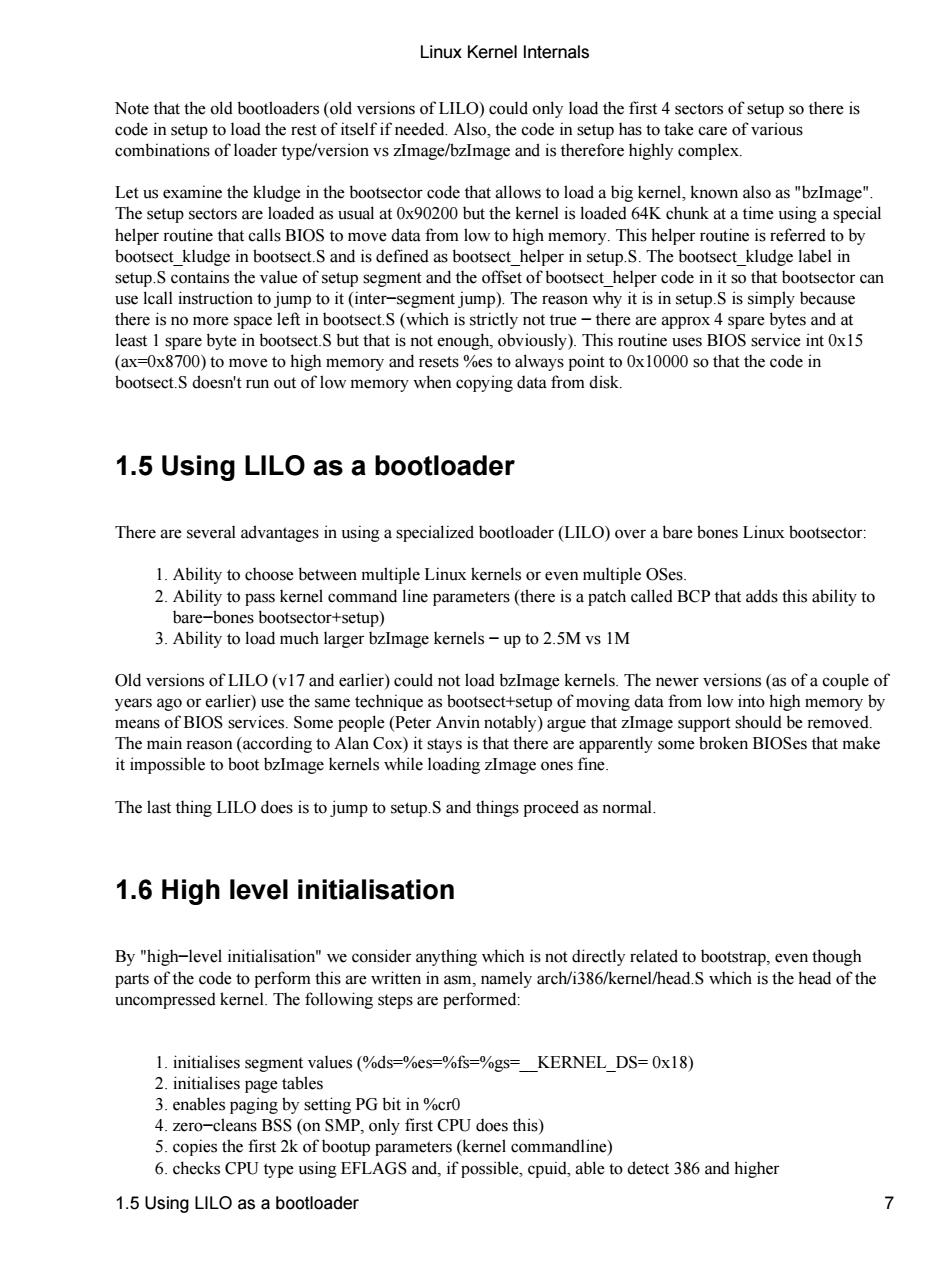正在加载图片...

Linux Kemnel Internals achteibioCromaA0Ooaoenoai中tcooiopehae6 combinations of loader type/version vs zImage/bzImage and is therefore highly complex. Let us examine the kludge in the bootsector code that allows to load a big kernel known also as "bzImage" The setup sectors are loaded as usual at 0x90200 but the kernel is loaded 64K chunk at a time using a specia helper routine that calls BIOS to move data from low to high memory.This helper routine is referred to by bootsect_kludge in bootsect.S and is defined as bootsect_helper in setup.S.The bootsect_kludge label in setup.S contains the value of setup segment and the offset of bootsect helper code in it so that bootsector can use lcall instruction to jump to it (inter-segment jump).The reason why it is in setup.S is simply because there is no more space left in bootsect.S(which is strictly not true- there are approx 4 spare bytes and at least I spare byte in bootsect.S but that is not enough,obviously).This routine uses BIOS service int 0x15 (ax-0x8700)to move to high memory and resets %es to al ways point that the code in bootsect.S doesn't run out of low memory when copying data from disk 1.5 Using LILO as a bootloader There are several advantages in using a specialized bootloader(LILO)over a bare bones Linux bootsector veen multi s ke omm 3.much arger m kemels -up to 2.5M vs IM Old versions of LILO(v17 and earlier)could no load bzlm couple of vears ago or earlier)use the ame e as hoo ata m ry by means of BIOS ser ple (Peter Anvin notably)argue that zImage port she uld he The main reason (according to lan Cox)itsta ys is that there are s pparently some broken BIOSes that make it impossible to boot bzImage kemels while loading zlmage ones fine The last thing LILO does is to jump to setup.S and things proceed as normal 1.6 High level initialisation By"high-level initialisation"we consider anything which is not directly related to bootstrap,even though parts of the code to perform this are written in asm,namely arch/i386/kernel/head.S which is the head of the uncompressed kernel.The following steps are performed: 1.initialises segment values(%ds=%es-%fs=%gs=KERNEL DS=0x18) 2.initialises page tables 3.enables paging by setting PG bit in %cr 4.zero-cleans BSS (on SMP,only first CPU does this) 5.copies the first 2k of bootup parameters(kernel commandl ne) 6.checks CPU type using EFLAGS and,if possible,cpuid,able to detect 36 and higher 1.5 Using LILO as a bootloader 7Note that the old bootloaders (old versions of LILO) could only load the first 4 sectors of setup so there is code in setup to load the rest of itself if needed. Also, the code in setup has to take care of various combinations of loader type/version vs zImage/bzImage and is therefore highly complex. Let us examine the kludge in the bootsector code that allows to load a big kernel, known also as "bzImage". The setup sectors are loaded as usual at 0x90200 but the kernel is loaded 64K chunk at a time using a special helper routine that calls BIOS to move data from low to high memory. This helper routine is referred to by bootsect_kludge in bootsect.S and is defined as bootsect_helper in setup.S. The bootsect_kludge label in setup.S contains the value of setup segment and the offset of bootsect_helper code in it so that bootsector can use lcall instruction to jump to it (inter−segment jump). The reason why it is in setup.S is simply because there is no more space left in bootsect.S (which is strictly not true − there are approx 4 spare bytes and at least 1 spare byte in bootsect.S but that is not enough, obviously). This routine uses BIOS service int 0x15 (ax=0x8700) to move to high memory and resets %es to always point to 0x10000 so that the code in bootsect.S doesn't run out of low memory when copying data from disk. 1.5 Using LILO as a bootloader There are several advantages in using a specialized bootloader (LILO) over a bare bones Linux bootsector: 1. Ability to choose between multiple Linux kernels or even multiple OSes. 2. Ability to pass kernel command line parameters (there is a patch called BCP that adds this ability to bare−bones bootsector+setup) 3. Ability to load much larger bzImage kernels − up to 2.5M vs 1M Old versions of LILO (v17 and earlier) could not load bzImage kernels. The newer versions (as of a couple of years ago or earlier) use the same technique as bootsect+setup of moving data from low into high memory by means of BIOS services. Some people (Peter Anvin notably) argue that zImage support should be removed. The main reason (according to Alan Cox) it stays is that there are apparently some broken BIOSes that make it impossible to boot bzImage kernels while loading zImage ones fine. The last thing LILO does is to jump to setup.S and things proceed as normal. 1.6 High level initialisation By "high−level initialisation" we consider anything which is not directly related to bootstrap, even though parts of the code to perform this are written in asm, namely arch/i386/kernel/head.S which is the head of the uncompressed kernel. The following steps are performed: 1. initialises segment values (%ds=%es=%fs=%gs=__KERNEL_DS= 0x18) 2. initialises page tables 3. enables paging by setting PG bit in %cr0 4. zero−cleans BSS (on SMP, only first CPU does this) 5. copies the first 2k of bootup parameters (kernel commandline) 6. checks CPU type using EFLAGS and, if possible, cpuid, able to detect 386 and higher Linux Kernel Internals 1.5 Using LILO as a bootloader 7